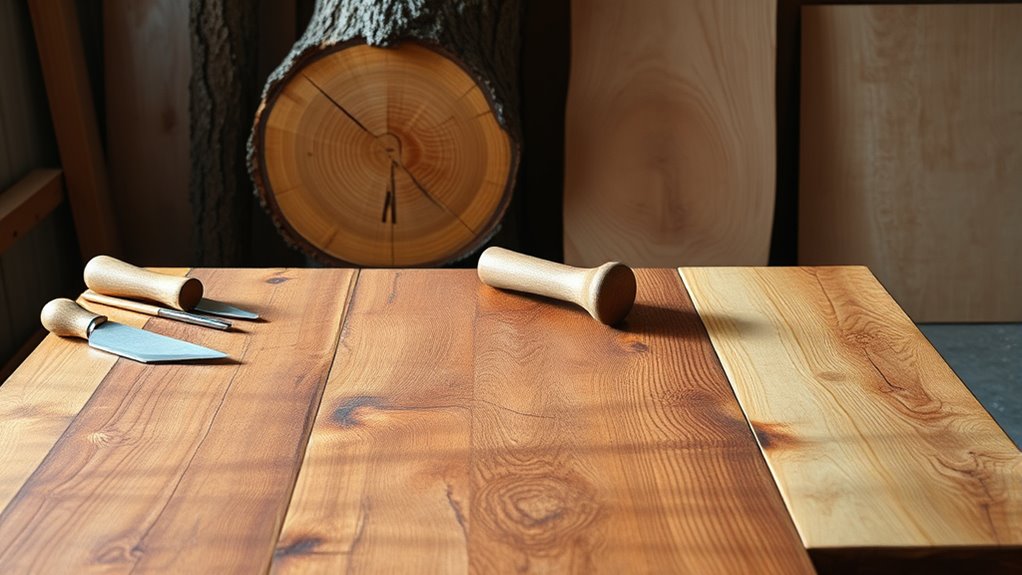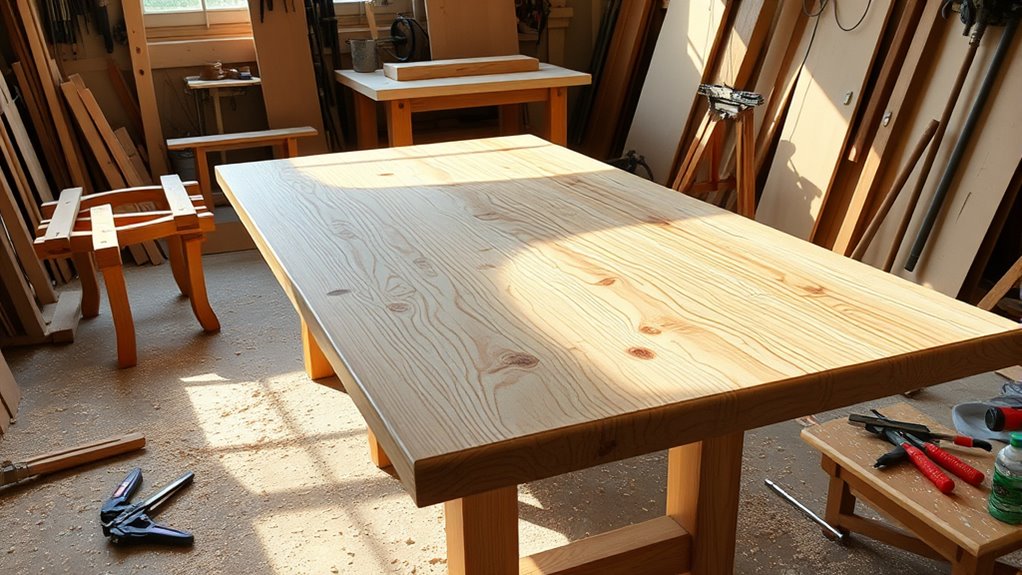From tree to table, your wood undergoes a careful journey. It starts with selecting mature trees, often urban or reclaimed, then responsibly harvests them without harming surrounding trees. The logs are sawn into lumber using advanced techniques, dried to a specific moisture level, and inspected for quality. Skilled craftsmanship shapes, joins, and finishes the wood into durable furniture. Proper care extends its life, ensuring your table remains beautiful for years. Learn more about each step in this fascinating process.
Key Takeaways
- Selects mature, strong trees responsibly, often upcycling urban or storm-damaged hardwoods for sustainable sourcing.
- Logs are sawed using precise methods like plain-sawing or quarter sawing to determine grain and stability.
- Wood is dried and cured in controlled environments to reduce moisture content and prevent defects.
- Skilled craftsmen shape, join, and finish the wood with traditional and modern techniques for durability and beauty.
- Proper maintenance and care ensure the longevity and aesthetic appeal of the finished wooden furniture.
Selecting and Harvesting the Perfect Trees

Choosing the right trees is essential for crafting high-quality furniture, so you need to carefully assess their size, age, and health. When selecting a tree, focus on those that are mature and show signs of strength and stability. Proper choosing ensures you pick trees that offer durable, beautiful wood suitable for fine furniture. Responsible harvesting involves evaluating the tree’s condition without harming surrounding trees, which helps maintain the forest’s ecological balance. Urban hardwoods, like storm-damaged oak, maple, and walnut, are often upcycled, reducing environmental impact. Always check for trees that meet specific criteria for quality, appearance, and durability. This careful selecting process guarantees you harvest trees that will produce furniture that’s both beautiful and long-lasting, while supporting sustainable forest management. Additionally, considering the availability of reclaimed wood can contribute to eco-friendly practices and reduce the need for new tree harvesting. Opting for urban wood sources can further promote sustainable use of existing materials and reduce pressure on forest ecosystems. Ensuring proper harvesting techniques also minimizes ecological disruption and encourages healthy forest regeneration.
The Sawing Process: Transforming Logs Into Lumber

Once logs arrive at the sawmill, they undergo a thorough inspection and preparation process to make sure they’re ready for cutting. During this stage, logs are transported to the sawmill and sorted based on size and quality. The primary sawing methods include plain-sawing and quarter sawing. Quarter sawing produces stable, ray-flake boards with a uniform grain pattern, ideal for certain applications, while plain-sawing creates large, varied-grain boards. The cutting process involves passing logs through large circular or band saw blades, which carefully slice them into planks of desired dimensions. The sawing technique chosen directly affects the wood’s strength, appearance, and grain orientation. Properly selecting sawing techniques can also influence the overall cost of lumber production. After sawing, the lumber is sorted, sometimes planed, and prepared for the next steps in processing. Embracing efficient sawing practices can contribute to increased productivity and better utilization of raw materials. Additionally, advancements in sawing technology continue to improve efficiency and reduce waste in the industry, reflecting ongoing innovations in wood processing methods. Incorporating sustainable forestry practices ensures that the wood used is harvested responsibly, supporting eco-friendly living.
Drying and Curing: Preparing the Wood for Use

To guarantee wood is suitable for furniture making, it must undergo a drying process called curing that reduces its moisture content to an ideal level. During drying, you can use kiln-drying, where the wood is placed in a controlled environment with regulated temperature and humidity. This process typically takes several weeks and ensures the moisture content drops to between 6% and 8%, perfect for indoor furniture. Proper curing prevents issues like warping, shrinking, or cracking once the wood is assembled. It also helps distribute internal moisture evenly, boosting the wood’s structural stability and longevity. Additionally, understanding the moisture content of wood is essential for ensuring optimal results in furniture production. Monitoring and controlling moisture levels during the drying process can further improve the quality and durability of the finished product. Knowing the appropriate drying methods can make a significant difference in achieving a high-quality final product. Employing proper techniques, such as controlled environment drying, ensures the wood maintains its desired properties and minimizes defects. Recognizing the importance of consistent humidity control during drying can also prevent uneven drying and related problems.
Crafting With Skill: Shaping and Joinery Techniques

Crafting with skill involves precise shaping and joinery techniques that guarantee your furniture is both strong and beautiful. Shaping methods like carving, routing, and planing ensure each component fits perfectly, enhancing the piece’s aesthetic. Skilled artisans use traditional joinery methods such as dovetailing, mortise and tenon, and dowels to create strong, durable connections without nails or screws. These joints are carefully crafted and reinforced through clamping and gluing to maintain structural integrity over time. Modern tools like CNC machines and routers complement hand tools, allowing for intricate detail and consistency. Proper shaping and joinery not only guarantee stability but also highlight the natural beauty of the wood, setting the foundation for a timeless, well-crafted piece. Discover endless fun with innovative techniques and creative designs that make woodworking a rewarding hobby.
Finishing Touches: Enhancing Beauty and Durability

Finishing touches are the final step in transforming a well-crafted piece into a stunning and durable piece of furniture. During the finishing process, you’ll apply stains, oils, or clear coats to highlight the wood’s natural color and grain. Protective finishes like polyurethane or varnish form a tough surface that resists moisture, scratches, and everyday wear. Multiple layers are carefully applied, with sanding between coats to ensure a smooth, polished look. You might also add decorative details such as inlays, carvings, or hand-painted accents to personalize your piece and showcase craftsmanship. Proper finishing not only enhances the visual appeal but also extends the furniture’s lifespan by safeguarding it against environmental damage, ensuring your creation remains beautiful and functional for years to come.
Assembling and Finalizing the Furniture Piece

Assembling and finalizing a furniture piece requires careful attention to detail and precise techniques to guarantee strength and durability. During final assembly, you’ll connect components using joinery methods like dovetailing, mortise and tenon, or dowel joints, ensuring each piece fits perfectly. Craftsmen carefully align and clamp parts to create seamless connections, which are essential for stability. Once assembled, surface finishing steps such as sanding, staining, and sealing are performed to enhance the wood’s appearance and protect it from wear. Proper sanding techniques are crucial to achieve a smooth, professional finish and prepare the surface for staining or sealing. It is also important to monitor for digital literacy to ensure safety when using power tools during assembly. Finally, thorough quality control inspections confirm all joints are secure, surfaces smooth, and the assembled furniture meets both aesthetic and durability standards.
Caring for Your Wooden Table to Ensure Longevity

To keep your wooden table looking its best and lasting for years, proper care is essential. When your table is new, gently clean it with a soft, damp cloth, avoiding harsh chemicals that can damage the wood’s natural beauty. Use coasters, placemats, and felt pads to prevent scratches, stains, and heat damage. Every 6 to 12 months, apply a high-quality furniture wax or oil to maintain moisture and enhance durability. Keep the table away from direct sunlight and extreme temperature changes to prevent warping and fading. Immediately wipe up spills to avoid moisture absorption and staining. For added protection, consider applying a sealant. Proper wooden furniture maintenance techniques can further extend its lifespan, especially when combined with regular cleaning routines. Additionally, ensuring proper self watering plant pots care can help prevent excess moisture from damaging nearby furniture. Recognizing the importance of essential oils for wood preservation can also contribute to maintaining your furniture’s condition. With these steps, your wooden table will retain its charm and function beautifully for years to come.
Frequently Asked Questions
What Is the Wood From the Trees Analogy?
The “Wood from the Trees” analogy helps you understand a complex subject by breaking it down into its individual parts. You see each tree as a piece of the whole, just like each detail or component in a topic. By examining each part carefully, you build a complete understanding. This analogy reminds you that appreciating every step, from raw material to finished product, is essential for truly grasping the entire process.
What Is the Saying See the Wood Through the Trees?
Imagine you’re lost in a forest, staring at individual trees while missing the entire landscape. That’s what “see the wood through the trees” advises. You need to step back, take in the big picture, and avoid fixating on tiny details. It’s about perspective—recognizing the whole forest instead of obsessing over each tree. This way, you appreciate the full scope, making smarter decisions and truly understanding your surroundings.
What Does the Wood From the Tree Mean?
When you hear “wood from the tree,” it means the raw timber taken directly from a living or dead tree before any processing. You’re looking at the natural, unrefined state, showing its unique grain, color, and characteristics. It reminds you that the quality of finished wood products depends on the original tree’s species, age, and growing conditions. This phrase highlights the connection between nature and the crafted items you use every day.
Where Does the Phrase “Can’t See the Wood for the Trees” Come From?
You’re asking where the phrase “can’t see the wood for the trees” comes from. It originates from British English in the 16th century, symbolizing how focusing on small details can make it hard to see the bigger picture. The idiom compares this to being unable to distinguish individual trees in a dense forest. It reminds you to step back and consider the whole situation instead of getting lost in minor elements.
Conclusion
Now you see how every step transforms a simple tree into a stunning piece of furniture that could outlast centuries. With careful selection, expert craftsmanship, and your love and care, your wooden table becomes more than just furniture—it becomes a timeless heirloom. Think of it as a living story etched in wood, ready to withstand the test of time and countless gatherings. Your dedication turns raw timber into a masterpiece that truly stands the test of history.









